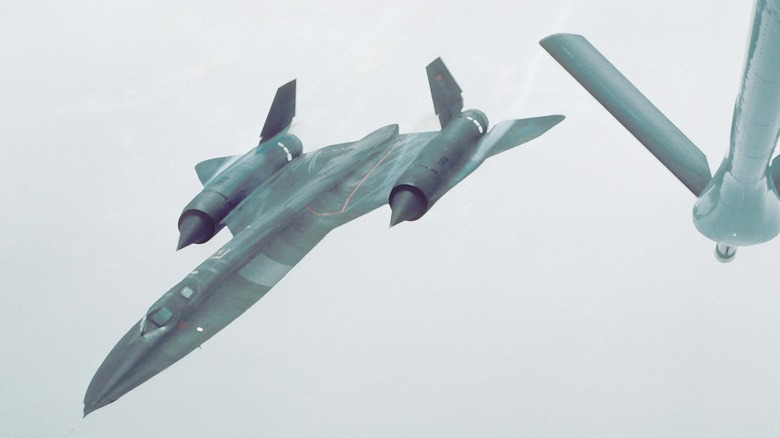Who Designed The SR-71 Blackbird Jet, And Where Was It Built?
There are certain planes that are so special that their very name is spoken in hushed tones. The legendary SR-71 Blackbird is one such craft. Designed during the Cold War, the Blackbird was a replacement for the U-2 spy plane, one of which had been shot down as it flew over the Soviet Union at a height of 70,000 feet in 1960, rushing the need for a replacement. As luck would have it, the clever people at the Lockheed Aircraft Corporation (known today as Lockheed Martin) were already on the case. More specifically, the Lockheed Advanced Development Group — or Skunk Works, as it's better known — was working on a faster and higher-flying reconnaissance aircraft, featuring a minimal radar cross-section. The latter was aided by its black radar-absorbing paint that gave the SR-71 its "Blackbird" nickname.
Under pressure from Washington, the Skunk Works crew, led by the legendary Kelly Johnson, was tasked with turning the project into a reality and doing so as quickly as possible. It's a testament to the dedication and skill of the engineers that the first full-sized SR-71 flew on December 22, 1964 (a smaller A-12 Blackbird flew on April 30, 1962). The Skunk Works team was based in an anonymous, cream and rust colored building tucked away in a corner of Burbank Airport, California. It was from this unassuming windowless building that a legend was born. It was here that the SR-71 was built.
Everything had to be invented for the SR-71
While it would be wrong to say that we take the technologies built into fifth-generation fighters like the advanced F-35 Lightning II for granted, these marvels were evolutions of existing designs. Whereas, according to Kelly Johnson, with the SR-71, "Everything had to be invented. Everything." And this was expected of a plane that had to be flying in under two years, which the A-12 did. The brief was the toughest that Johnson had ever faced. It included performance metrics like an efficient cruise speed of MACH 3.2 (2,445 mph), a flight ceiling of over 85,000 feet, and the ability to cope with leading-edge temperatures of over 1,000 degrees Fahrenheit. The metal chosen for the plane was titanium. This, in itself, caused the Skunk Works team several headaches — titanium was brittle to work with, and existing machining tools "embrittled" the material. New training programs and specially built titanium tools had to be introduced.
Ultimately, history testifies to the success of the project. In total, 32 of the aircraft were produced from Lockheed's unassuming Burbank factory. And although 12 planes were lost to accidents, not one was ever lost to enemy action. A tally more impressive because the SR-71 has spent more time in hostile airspace than any other reconnaissance aircraft and has had hundreds of SAMs fired at it. As a final testament, it's worth noting that even although the last two airworthy SR-71s were retired by NASA in 1999, the Blackbird remains one of the most revered US planes ever.

